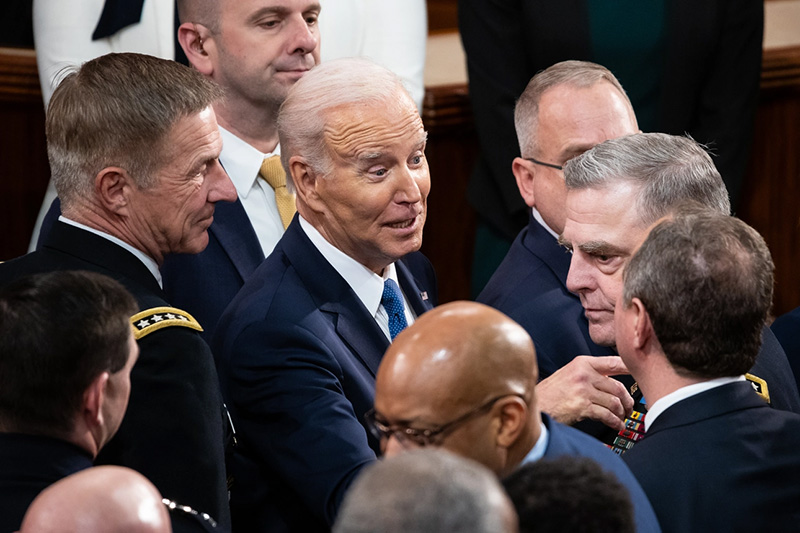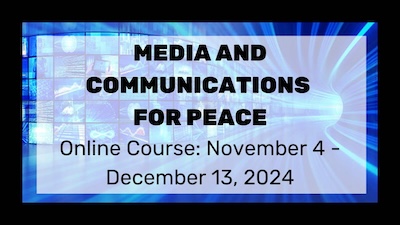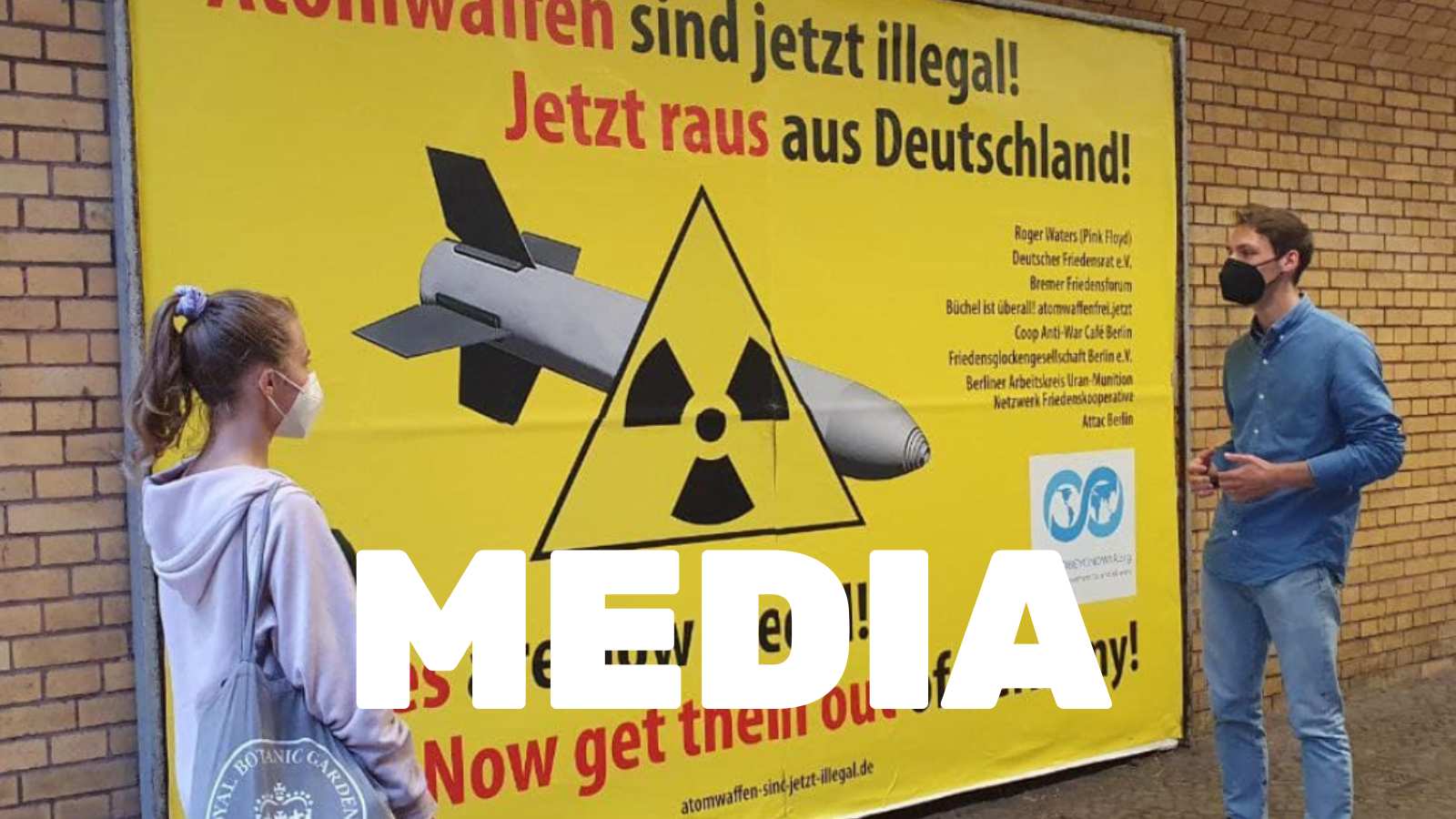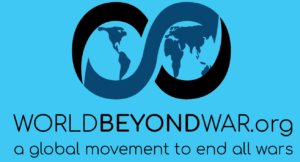
President Biden speaks to General Mark Milley after his 2023 State of the Union speech. Photo credit: Francis Chung/Politico
By Medea Benjamin and Nicolas J. S. Davies, World BEYOND War, August 16, 2023
President Biden wrote in the New York Times in June 2022 that the United States was arming Ukraine to “fight on the battlefield and be in the strongest possible position at the negotiating table.”
Ukraine’s fall 2022 counteroffensive left it in a stronger position, yet Biden and his NATO allies still chose the battlefield over the negotiating table. Now the failure of Ukraine’s long-delayed “Spring Counteroffensive” has left Ukraine in a weaker position, both on the battlefield and at the still empty negotiating table.
So, based on Biden’s own definition of U.S. war aims, his policy is failing, and it is hundreds of thousands of Ukrainian soldiers, not Americans, who are paying the price, with their limbs and their lives.
But this result was not unexpected. It was predicted in leaked Pentagon documents that were widely published in April, and in President Zelenskyy’s postponement of the offensive in May to avoid what he called “unacceptable” losses.
The delay allowed more Ukrainian troops to complete NATO training on Western tanks and armored vehicles, but it also gave Russia more time to reinforce its anti-tank defenses and prepare lethal kill-zones along the 700-mile front line.
Now, after two months, Ukraine’s new armored divisions have advanced only 12 miles or less in two small areas, at the cost of tens of thousands of casualties. Twenty percent of newly deployed Western armored vehicles and equipment were reportedly destroyed in the first few weeks of the new offensive, as British-trained armored divisions tried to advance through Russian minefields and kill-zones without demining operations or air cover.
Meanwhile, Russia has made similar small advances toward Kupyansk in eastern Kharkiv province, where land around the town of Dvorichna has changed hands for the third time since the invasion. These tit-for-tat exchanges of small pieces of territory, with massive use of heavy artillery and appalling losses, typify a brutal war of attrition not unlike the First World War.
Ukraine’s more successful counteroffensives last fall provoked serious debate within NATO over whether that was the moment for Ukraine to return to the negotiating table it had abandoned at British and U.S. urging in April 2022. As Ukrainian forces advanced on Kherson in early November, La Republicca in Italy reported that NATO leaders had agreed that the fall of Kherson would put Ukraine in the position of strength they had been waiting for to relaunch peace talks.
On November 9, 2022, the very day that Russia ordered its withdrawal from Kherson, General Mark Milley, the Chairman of the Joint Chiefs of Staff, spoke at the Economic Club of New York, where the interviewer asked him whether the time was now ripe for negotiations.
General Milley compared the situation to the First World War, explaining that leaders on all sides understood by Christmas 1914 that that war was not winnable, yet they fought on for another four years, multiplying the million lives lost in 1914 into 20 million by 1918, destroying five empires and setting the stage for the rise of fascism and the Second World War.
Milley concluded his cautionary tale by noting that, as in 1914, “… there has to be a mutual recognition that military victory is probably in the true sense of the word, is maybe not achievable through military means. And therefore, you need to turn to other means… So things can get worse. So when there’s an opportunity to negotiate, when peace can be achieved, seize it, seize the moment.”
But Milley and other voices of experience were ignored. At Biden’s February State of the Union speech in Congress, General Milley’s face was a study in gravity, a rock in a sea of misplaced self-congratulation and ignorance of the real world beyond the circus tent, where the West’s incoherent war strategy was not only sacrificing Ukrainian lives every day but flirting with nuclear war. Milley didn’t crack a smile all night, even when Biden came over to glad-hand after his speech.
No U.S., NATO or Ukrainian leaders have been held accountable for failing to seize that moment last winter, nor the previous missed chance for peace in April 2022, when the U.S. and UK blocked theTurkish and Israeli mediation that came so close to bringing peace, based on the simple principle of a Russian withdrawal in exchange for Ukrainian neutrality. Nobody has demanded a serious account of why Western leaders let these chances for peace slip through their fingers.
Whatever their reasoning, the result is that Ukraine is caught in a war with no exit. When Ukraine seemed to have the upper hand in the war, NATO leaders were determined to press their advantage and launch another offensive, regardless of the shocking human cost. But now that the new offensive and weapons shipments have only succeeded in laying bare the weakness of Western strategy and returning the initiative to Russia, the architects of failure reject negotiating from a position of weakness.
So the conflict has fallen into an intractable pattern common to many wars, in which all parties to the fighting—Russia, Ukraine and the leading members of the NATO military alliance—have been encouraged, or we might say deluded, by limited successes at different times, into prolonging the war and rejecting diplomacy, despite appalling human costs, the rising danger of a wider war and the existential danger of a nuclear confrontation.
But the reality of war is laying bare the contradictions of Western policy. If Ukraine is not allowed to negotiate with Russia from a position of strength, nor from a position of weakness, what stands in the way of its total destruction?
And how can Ukraine and its allies defeat Russia, a country whose nuclear weapons policy explicitly states that it will use nuclear weapons before it will accept an existential defeat?
If, as Biden has warned, any war between the United States and Russia, or any use of “tactical” nuclear weapons, would most likely escalate into full-scale nuclear war, where else is the current policy of incremental escalation and ever-increasing U.S. and NATO involvement intended to lead?
Are they simply praying that Russia will implode, or give up? Or are they determined to call Russia’s bluff and push it into an inescapable choice between total defeat and nuclear war? Hoping, or pretending, that Ukraine and its allies can defeat Russia without triggering a nuclear war is not a strategy.
In place of a strategy to resolve the conflict, the United States and its allies harnessed the natural impulse to resist Russian aggression onto a U.S. and British plan to prolong the war indefinitely. The results of that decision are hundreds of thousands of Ukrainian casualties and the gradual destruction of Ukraine by millions of artillery shells fired by both sides.
Since the end of the First Cold War, successive U.S. governments, Democratic and Republican, have made catastrophic miscalculations regarding the United States’ ability to impose its will on other countries and peoples. Their wrong assumptions about American power and military superiority have led us to this fateful, historic crisis in U.S. foreign policy.
Now Congress is being asked for another $24 billion to keep fueling this war. They should instead listen to the majority of Americans, who, according to the latest CNN poll, oppose more funding for an unwinnable war. They should heed the words of the declaration by civil society groups in 32 countries calling for an immediate ceasefire and peace negotiations to end the war before it destroys Ukraine and endangers all of humanity.
Medea Benjamin and Nicolas J. S. Davies are the authors of War in Ukraine: Making Sense of a Senseless Conflict, published by OR Books in November 2022.
Medea Benjamin is the cofounder of CODEPINK for Peace, and the author of several books, including Inside Iran: The Real History and Politics of the Islamic Republic of Iran.
Nicolas J. S. Davies is an independent journalist, a researcher for CODEPINK and the author of Blood on Our Hands: The American Invasion and Destruction of Iraq.









One Response
Thank you for your work. So good to see a “declaration by civil society groups in 32 countries calling for an immediate ceasefire and peace negotiations to end the war.”